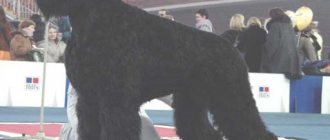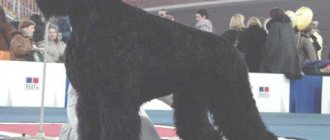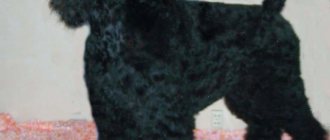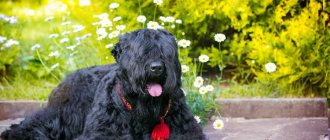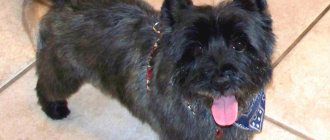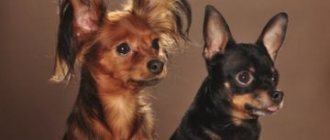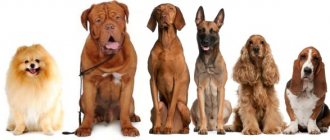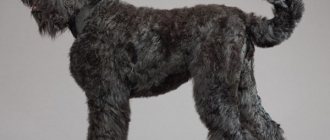The dog we want to introduce you to is not quite ordinary. This is a real Soviet breed, which at one time bore the loud names “black death”, “Beria’s dog”, “Stalin’s dog”, “black lightning”. Those who are not familiar with this breed claim that they are aggressive, angry and difficult to train. Yes, the black or Stalin terrier was bred as a special-purpose guard breed. But this does not mean that he cannot be a sensitive and kind companion, which we will try to prove to you in our review.
Breed characteristics
| Short description | |
| Origin: | USSR |
| Conditions of detention: | In a house with a large garden |
| Purpose: | Sentry |
| Color: | Black |
| Wool length: | 5-15 cm |
| Adult dog size: | The height of females is 68-72 cm, males 72-76, weight of males is about 50-60 kg, females - 45-50 kg |
| Average life expectancy: | 9-14 years |
| Walk: | Puppies are walked 5 times a day, an adult dog 2 times a day |
| Physical activity needs: | Average physical activity needs (walking 1 to 3 hours per day) |
| Fédération Cynologique Internationale (FIC) classification: | Group No. 2 Pinscher and schnauzer, Molosser, mountain and Swiss cattle dogs; Section No. 1 pinschers and schnauzers |
| Puppy price: | From 10 to 30 thousand rubles.
|
History of the origin of the species
Stalin's dog was first bred for the Russian army at the end of World War II. This breed can work in harsh climate conditions: heat and cold. Three breeds were used to breed it: the huge schnauzer, the Newfoundland and the Airedale terrier.
Black terriers were highly valued in Russia not only as highly skilled and courageous service dogs, but also as loyal and devoted pets.
These dogs were used by the Red Army to track down fugitives.
Health
In general, the black terrier can be called a hardy and healthy dog, although, like many other breeds, they have their “weak points”. For example, due to their large size and weight, blackies are prone to dysplasia of the elbow and hip joints. In addition, they are often diagnosed with problems with the ears and eyes, in particular, progressive retinal atrophy. Once every 6 months, the black chick needs to be shown to a specialist and proper disease prevention should be carried out.
Loading …
Distinctive features
The main distinguishing features of the Black Russian Terrier are:
- The head is proportional to the body. It is equal to the length of the neck and at least 40% of the height of the dog at the withers.
- The eyes are oval, medium in size, dark and relatively widely spaced.
- The ears are medium in size, triangular in shape, high, but not higher than the level of the skull. The skin of the ear is dense, rounded towards the bottom, hanging with the leading edge on the head.
- The muzzle is wide with a slight narrowing towards the nose. The mustache and beard emphasize the volume and give it a square shape.
- The nose is large and black.
- bite . The teeth are large and white. The incisors form a straight line at the base.
- The neck is muscular and powerful. The length is the same as the length of the head.
- The body gives the impression of an oval sternum with wide and well-proportioned ribs.
- The tail is thick, set moderately high and at 45 degrees horizontally. The shape resembles a sickle or saber.
- Color only black.
Until 2007, in all countries of the world the tail of the black Russian terrier was docked; now this procedure is prohibited.
Usage
The Black Russian Terrier is one of the popular breeds in Russian service and departmental cynology. This dog should receive regular physical and mental exercise. Black terriers are not well suited for the quiet life of a companion dog and need activities appropriate to their purpose.
Most often, sports dog handlers perform with RCT in such disciplines as general training course, protective guard service, Russian ring, big ring, IGP, obedience. Departmental dog handlers also use Russian black terriers to search for narcotic and explosive substances, detain and escort violators, guard duty, border service and territory protection[3].
Photo of an adult dog
Photos of puppies
Features of character and behavior
The Black Russian Terrier has a very calm, confident and safe character. He is extremely friendly and outgoing towards his family, but is aloof and distrustful of strangers due to his natural protective instinct. This breed is very good with children and is very trainable. Black Terriers do not suffer from separation anxiety, making them an ideal watchdog.
Black Russian Terriers form strong bonds with their owners and always try to please them. However, for proper training, it is necessary to indicate to the dog who is dominant in the house. This breed is very energetic and is well suited for people with an active lifestyle. In addition, they are well suited for guarding the house and hunting wild animals. At the same time, they do not conflict and do not behave aggressively towards other pets.
Black Russian Terriers are very playful, so they need long walks.
Advantages
The main advantages of this breed include:
- Strong and robust physique;
- Big sizes;
- Harmonious physique;
- Good health;
- Easy to care for;
- Mind;
- Lack of aggression towards children and other pets;
- Wary of strangers;
- Adaptability to heat or cold;
- No seasonal shedding.
Flaws
Along with the advantages, there are also disadvantages, which include:
- The coat requires constant trimming and combing;
- Puppies under 1 year of age require careful and strict training;
- Not suitable for beginners;
- An adult dog needs long and hard training.
Abstracts
- BRT is born for service and they must work, without it they are unhappy. If this is not a service dog, but a companion, you can load it with culture and sports such as agility.
- The minimum load is 30 minutes a day. They do best in a fenced yard, but with enough loads Russian Terriers can live in an apartment.
- They bark and they shed little, but this dog cannot do without hair and noise.
- I love my family, being close to people and communication. This is not a dog that needs to be kept on a chain.
- They are a little stubborn, but smart and they need a company owner who does not allow them to break the rules.
- By nature they are distrustful of strangers; they will be patient with socialization, but not welcome. They will be protected until their last breath.
- I love children, I forgive them even their rude attitude. But, you still shouldn't leave a large dog with a child.
Care and maintenance
The black terrier lives well both in an apartment and in a house on the ground. All he needs is a place to train and play. In addition, a large bed that is not electrified will be enough for him.
This breed does not require special care. Due to its thick coat, the dog needs to be bathed once a month and preferably brushed daily. However, you must remember to trim your nails once a month and clean your ears once every 2 weeks. Debris may collect in the corners of the eyes, which should also be removed with a damp cotton pad.
In addition, they need regular physical activity in the form of games and jogging. These dogs love to be near people, so keeping them in a kennel is unacceptable.
Nutrition
For the Black Russian Terrier, high-quality food should be carefully selected. This can be dry food from a commercial manufacturer, when choosing which it is important to take into account the quality of raw materials and the amount of useful ingredients. Or food prepared at home, in compliance with all proportions:
- Proteins – 20% or 4 g/kg.
- Fats – 5% or 1 g/kg.
- Carbohydrates – 75% or 15 g/kg.
Any diet should be appropriate for the age of the dog (puppy, adult dog, elderly).
Some terriers tend to be overweight, so monitoring their caloric intake is essential for weight control.
It is very important that your dog always has access to clean and fresh water.
Prohibited products include:
- Sweets;
- Smoked and fried foods;
- Fatty meat products;
- Tubular bones.
While the Black Russian Terrier is a puppy, it must be fed properly, usually 4-5 meals; veterinarians recommend the following amount of natural food per day:
- 2 months – 286-357 grams;
- 3 months – 365-460 grams;
- 4 months – 400-495 grams;
- 5 months – 454-577 grams;
- 6 months – 505-649 grams;
- 7 months – 506-650 grams;
- 8 months – 471-646 grams;
- 9 months – 440-606 grams;
- 10 months – 402-570 grams;
- 11 months – 365-525 grams;
- 12 months – 363-483 grams;
- 14 months – 357-476 grams.
After 15 months of life, the dog is considered an adult, and it needs to be fed 2 times a day, depending on its body weight:
- Up to 36 kg – 352-463 grams;
- Up to 45 kg – 409-538 grams;
- Up to 60 kg – 459-588 grams;
- Up to 68 kg – 509-638 grams.
In order to avoid problems with obesity, you need to consult a veterinarian on choosing the right diet.
We recommend that you read a detailed article on the topic: “How and what to feed a dog: types and characteristics of nutrition.”
Health
The Black Russian Terrier is in good health. Its lifespan ranges from 9 to 14 years . Despite their relatively long lifespan, these dogs, like most large breeds, are predisposed to certain hereditary diseases.
Vaccinations
Vaccinations for Black Russian Terriers are carried out in the same manner as for other breeds. Vaccination is carried out to prevent such terrible diseases as distemper and rabies. First, the primary vaccination is given, then revaccination is done. Typically, intramuscular or subcutaneous injections are used for this.
The vaccination schedule includes vaccinations against the following diseases:
- Rabies - at 3 months, then a year and repeat annually;
- Plague – 2 months, then a year and repeated annually;
- Infectious hepatitis - every 2 months, every year and repeated annually;
- Parvovirus enteritis - at 2.5 months, per year and repeated annually;
- Canine parainfluenza – 2 months, per year and repeated annually;
- Leptospirosis – 2.5 months, per year and repeated annually;
- Trichophytosis - 6 months, per year and repeat annually;
- Microsporia – 6 months, per year and repeated annually.
It is important to vaccinate dogs annually to avoid infectious diseases.
Important article on the topic: “Everything you need to know about dog vaccinations.”
Diseases
Canine studies have shown that the Black Russian Terrier is susceptible to such diseases as:
- Hip dysplasia . This is a condition where the hip bones do not develop properly. Later it can lead to concomitant diseases such as arthritis. X-rays are used for diagnosis, and then a veterinarian looks at the images. Although hip dysplasia has a genetic risk factor, its development can also be influenced by the environment.
- Elbow dysplasia . This is a condition in which abnormal bone development occurs, leading to arthritis in old age. Diagnosis occurs by x-ray examination. The leading risk factor is genetic predisposition.
- Hyperuricosuria . This is a disease in which uric acid does not dissolve, but forms crystals, which subsequently leads to urolithiasis. Most often, this disease affects dogs aged 3 to 6 years.
- Polyneuropathy . This pathology occurs with degenerative disorders in the nervous system. Clinical symptoms of this disease include problems with the hind legs and difficulty breathing, especially after physical activity.
- Ear infections . They are common due to the position of the ears of Russian Terriers.
When the first symptoms of incipient diseases appear, you should contact a veterinary clinic.
Walk
Black Russian Terriers are very active dogs. They require 40 minutes of daily training. Black Terriers in particular love lively walks in nature, and they will also be a good partner for cycling, swimming and even hiking. These dogs are always happy to play catch or frisbee.
This breed physiologically needs great physical activity. If you don’t deal with it, the consequences can be unpleasant and destructive. If a dog does not spend enough time with its owners, it may develop aggressive behavior.
Grooming
Stalin's dog has a thick, soft undercoat covered with a coarse protective layer that requires regular brushing and trimming to avoid blobs. To do this, you need to comb the dog with a long-toothed comb 2 times a week. This allows you not only to tidy up the coat, but also to improve blood flow under the skin.
In addition to trimming the fur itself, it is necessary to trim the dog's beard and whiskers carefully so that they look well-groomed and do not collect debris.
An untrimmed dog's muzzle can collect and bury food debris, leading to an unpleasant odor.
It is necessary to bathe your dog at least once a month, this will get rid of parasites and prevent an unpleasant odor. Regularly checking and cleaning your ears will help prevent ear infections.
Instructions for breeders of Black Russian Terriers
What is needed to raise a healthy, balanced, obedient dog that will bring joy in communication?
- Availability of free time. Terriers become attached to their owner and yearn for loneliness. The black puppy requires constant attention because it is extremely active and curious.
- Do not get a Black Terrier if you do not have the opportunity to organize a nutritious diet that includes the inclusion of high-quality meat products in the diet. Otherwise, the dog will grow up sick, with severe signs of rickets.
- Consider the opportunity to pay due attention to appearance while maintaining breed characteristics.
- Love your dog, exercise it, take care of its health, and then you will get great pleasure from communicating with a faithful friend.
Mating
Usually dogs of the same class are taken for mating. The show class is never bred with standard dogs. For a female that has a pedigree that has won several titles at exhibitions, a corresponding male is selected. To do this, the nursery takes special permits and evidence of belonging to this class.
Along with this, pairs are selected taking into account their type, character, and the male should also be larger than the female in size.
The age for mating varies: for females it is 2.5 years (usual after 3-4 heats), and for males it is 1.5 years. It is advisable to introduce the dogs before mating, but this is not a prerequisite. Mating is carried out on neutral territory to avoid conflict.
Read a detailed article on the topic: “Everything you need to know about breeding dogs: appropriate age, what to do if it doesn’t work out, rules and tips.”
Literature
- Vorobyova O.
Black Terrier // Friend: magazine. - 1996. - No. 5 (38). — P. 4-9. — ISSN 0868-6246. - Mishchikha O.
Black Russian Terrier // Friend: magazine. - 2004. - No. 1. - P. 6-14. - Mishchikha O.
Relatives of the Airedale Terrier // Friend: magazine. - 2009. - No. 12. - P. 37. - ISSN 1609-0527. - Gerasimova M.V.
Russian black terrier. - M.: AST, 2010. - ISBN 978-5-904880-40-8. - Yerusalimsky E. L.
Russian black terrier. Legends and reality // My friend the dog: magazine. - M.: Animal Press, 2012. - No. 1. - P. 47-50. - Falcon A.
Black Russian Terrier // My friend the dog: magazine. - M.: Animal Press, 2012. - No. 6. - P. 30.
Key points in training
Training is an integral part of any dog's life. The Black Russian Terrier has very good discipline, this is its meaning in life. This means that he is highly trainable and will follow his owner’s commands. In order to achieve results in training, constant repetition of what has been learned is necessary, so the dog will learn the information better.
An important fact is that this breed needs a lot of mental stimulation and consistency. This is important to prevent the development of unwanted behavior. Before you start teaching your dog special skills, you need to teach him basic commands, which include:
- To me;
- Place;
- Sit;
- Lie;
- Stop;
- Ugh.
Basic commands will help to avoid further problems during training, which will make it more productive.
Read about how to properly train a dog in the article: “Training a puppy: effective methods from dog handlers, learning commands at home.”
RCT professions: from security guard to canis therapist
The lively mind of black terriers helps them to be very versatile dogs. RCTs show brilliant results at competitions in protective guard service. But they are also excellent fashion models and athletes: canine freestyle, dancing with dogs, they have long submitted to gentle giants.
Detention of the defendant./Photo: s3.fotokto.ru
You won’t surprise blacks with a military career. However, “universal soldiers” are excellent nannies and “lecturers” on safe behavior with dogs in schools and kindergartens. Medical rehabilitation using specially trained dogs, canistherapy, has also been embraced by RCT. Therapeutic associations in Germany, Britain, Italy, Russia, Ukraine, and Poland report black terriers certified to help patients with cerebral palsy, ADHD, recovery from stroke, and socialization of people (including children) with autism.
Ukrainian canine therapist with a patient./Photo: v.img.com.ua
Did you like the article? Then support us, click
:
Black Russian Terrier
- a Russian service dog breed, bred in the second half of the 20th century in the USSR in the Krasnaya Zvezda kennel, by crossing the Giant Schnauzer, Airedale Terrier, Rottweiler, Newfoundland and others. The original breed was the Giant Schnauzer.
The dog is above average height, strong-boned, unpretentious to living conditions, resistant to colds, and lends itself well to various types of training. Currently [ when?
] the black Russian terrier has spread throughout the country[
which one?
] and has established itself as one of the best working breeds. This is an active participant in competitions in almost all service types of training: general training course, protective guard and sentry service, city dog, Russian ring, and so on.
How to choose a puppy
Choosing a puppy is very important because it cannot be changed or given away. When purchasing a dog, you need to understand that this is a family friend who will live with it not for a year or two, but for 10 or even 14 years. If you raise a puppy correctly, he will grow up to be a good guard dog and a faithful companion.
When buying a puppy, there are many aspects to consider in order to avoid problems in the future. These tips will help you choose a Black Russian Terrier puppy:
- Beware of scams . It happens that many advertisements offer beautiful puppies at low prices. However, sellers in this case ask for part of the money as an advance payment. Therefore, you should not buy a puppy over the Internet; it is best to come to the nursery and look at it.
- Mixed puppy . Quite often, nurseries began to cross various breeds with the Russian Terrier. As a result, a large number of non-purebred dogs appeared. While they are small, it is quite difficult to notice the difference, however, when the dog grows up, the features of a different breed will be clearly visible. In order to avoid this, it is necessary to request information from breeders about the parents of the puppies; it is desirable that this be documented information that indicates the breed and marks.
- Small puppy size . If the puppy is smaller in size than the others, then you should not assume that it will grow up healthy. Most often, these dogs are susceptible to diseases. You should select a puppy strictly according to proportions.
- When purchasing, you must make sure that the puppy’s parents have been vaccinated and have no hereditary diseases.
- Behavior . When choosing, you need to sit down and see how the puppy reacts; if he jumps away from fear towards the wall, this means that he is timid and will not be a good watchdog.
A good breeder will always answer all questions about the pedigree and parents of the puppy.
In conclusion, it should be noted that the Black Russian Terrier is an excellent companion and a good watchdog and hunting dog. He has excellent qualities and discipline for this. This dog is easy to care for, has a long lifespan and is easy to train. These important characteristics make it possible to make it not just a guard dog, but also a beloved family member. Black Russian Terriers are well suited for experienced and active people who love and carefully raise dogs.
Nutrition
Judging by the description of the Black Russian Terrier, it is already clear that he needs to eat well and fully. The dog is not particularly picky about food; he eats almost everything. But you need to know what you can and what you should not give to your pet.
There is an option like feeding dry food. This food contains all the vitamins and minerals, well-balanced fats-proteins-carbohydrates, and contains absolutely everything that is necessary for the full health of such a huge pet.
Many owners still prefer to feed their pets natural products. This, of course, is more expensive in terms of finances and takes much more time, but is the key to lasting health for the terrier, good condition of bones, teeth and coat.
A pet needs meat, but it should not be the main product. It is recommended to feed the dog lean lamb, beef, and veal every other day. You can also have turkey, rabbit and chicken. The meat is boiled and served raw.
The main product may be sea fish. It should have low fat content, be without bones and with the fins and tail removed (the dog can injure the mucous membrane of the oral cavity and digestive tract). Fish contains many useful substances - iodine, calcium, phosphorus, which are important for the health of the pet.
Raw and cooked seasonal vegetables are often added to meat. Basically, all individuals of this breed enjoy eating them. Experts strongly recommend adding a clove of garlic to prepared dishes from time to time. It will serve as an excellent means of prevention against all types of helminths.
Also, the dog needs cottage cheese, kefir and milk. They love buckwheat, rice and oatmeal. It is forbidden to give the terrier sweets, smoked meats, sausages, chocolate, and fast food products.
It is not recommended to combine feeding dry food and natural food. There is a high risk that the dog’s stomach will not cope with digestion. Without fail, the dog must be provided with cool, fresh water in large quantities.
